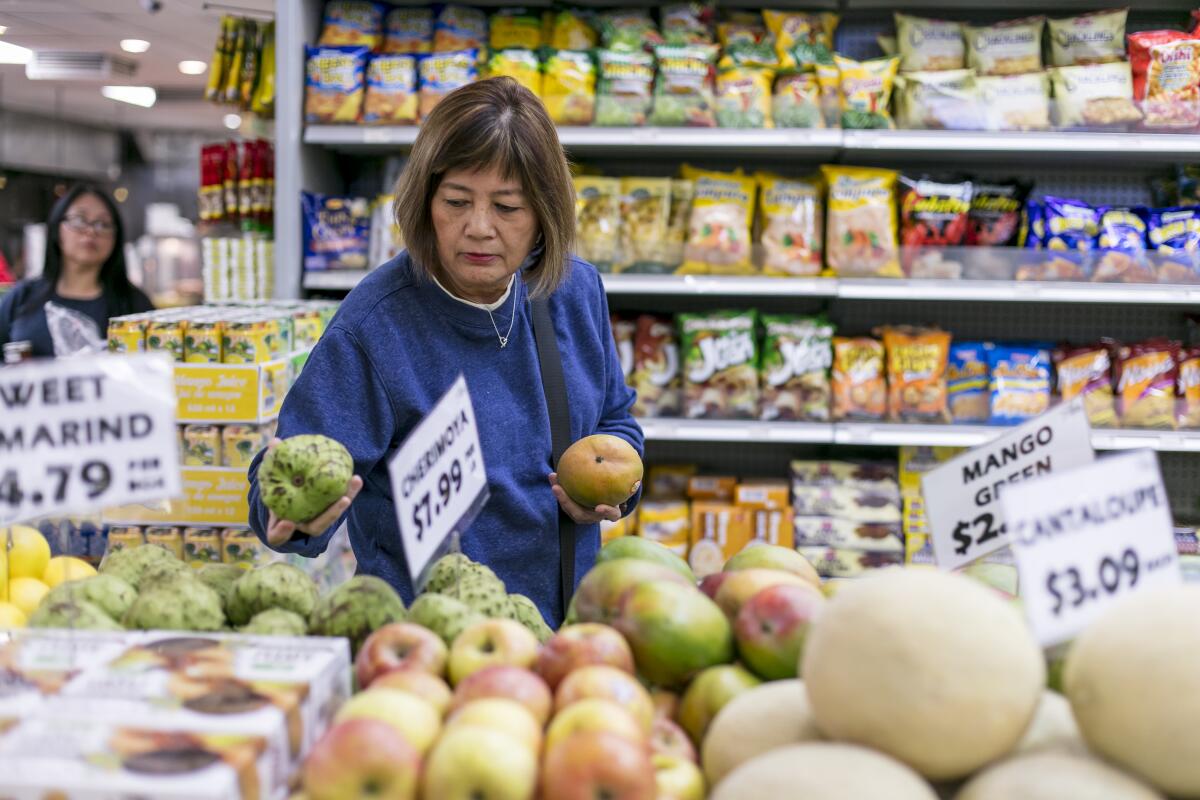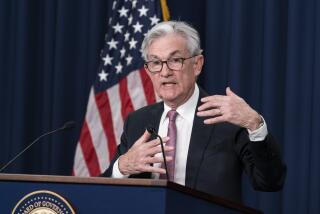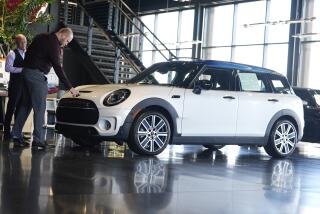In policy shift, the Fed projects three interest rate hikes in 2022

WASHINGTON — With inflation now running at its fastest pace in nearly 40 years and showing no signs of slowing down, the Federal Reserve on Wednesday abandoned its wait-and-see strategy and indicated that it could begin stepping on the economic brakes soon.
Specifically, the central bank signaled it could start raising interest rates as early as next spring as it announced a speedier shutdown of a bond-buying stimulus program that it implemented to counteract the economic damage from the COVID-19 pandemic. Most Fed officials now see at least three rate hikes in 2022.
Wednesday’s announcement, following policymakers’ last scheduled meeting of the year, marked a big pivot for Fed Chair Jerome H. Powell. He and his colleagues had put more emphasis on maximizing employment, rather than on the Fed’s other mandate, price stability, as they sought to achieve broad-based economic and job growth. Now the weight has shifted.
“For consumers, the writing is on the wall that interest rates are likely to start climbing in 2022. Now is the time to be making headway on paying off high-cost credit cards, consolidating debt at lower fixed rates, and refinancing the mortgage,” said Greg McBride, chief financial analyst at Bankrate.com.
As recently as a few months ago, Fed officials saw rising prices as a temporary consequence of supply chain disruptions and other problems stemming from the pandemic.
At that time, Fed policymakers seemed so confident that inflation would fade of its own accord that they mostly predicted interest rates would remain at historic, near-zero lows until at least 2023.
Now, the sharp shift may be welcomed by economists and others who doubted the Fed’s optimistic assessment, but it also adds a new element of uncertainty to a U.S. and global economy already uneasy about the future.
“My concern is that we’re going to go from a patient to a panicked Fed on inflation,” said Diane Swonk, chief economist at accounting firm Grant Thornton and a longtime Fed watcher.
Forced to make crucial policy decisions with far less than total information, the Fed is caught in a dilemma: If it does too little to combat inflation, that could feed widespread expectations that prices will continue to soar for months and years to come.
More workers, for example, might begin pushing harder for big pay increases, which would raise employers’ costs and fuel even more inflation. And businesses could begin raising prices to keep ahead of the curve.
On the other hand, if the Fed applies the brakes too hard, it could stifle the nascent economic recovery and push the country toward recession.
Adding to the uncertainty, although the overall economic growth looks strong, the total number of jobs in the U.S. remains almost 4 million short of what it was before COVID-19 struck.
And the fog over variants of the coronavirus and their effects on consumers and businesses add to the difficulty of forecasting exactly what the impact might be of different policy choices open to the Fed.
The Fed’s statement said it probably wouldn’t raise rates until its labor market goals were met, but Powell wasn’t specific about what would constitute “maximum employment.” And he left open the possibility that policymakers could nonetheless act preemptively to control inflation.
Powell noted that the economy today is very strong. But a surge in demand for goods has exacerbated production and supply problems, including shortages of semiconductors and raw materials, as well as labor.
At the same time, consumer spending and prices of stocks and houses have been juiced by trillions of dollars of fiscal pandemic aid and extraordinary monetary support from the Fed, including massive purchases of Treasury and mortgage securities. Increasing the money supply itself can add inflationary pressures.
A bunch of other factors have added fuel to the fire: Companies have seized the chance to make up revenue they lost during lockdowns, raising prices in many cases. Workers have seized the chance to demand more money and better working conditions. Politicians have seized the chance to turn the country’s problems into opportunities for themselves and their favored groups.
“It’s really a tightrope act, and the risk of a misstep by the Fed goes up because there are so many things happening at once,” Swonk said.
About two weeks ago, Powell said it was time to drop the word “transitory” in describing the run-up in inflation, a view that policymakers, including officials in the Biden administration, had espoused for months but could no longer support after persistent price increases.
What hasn’t changed in Powell’s thinking is that policy will be dictated largely by the course of the pandemic.
And that may be the biggest reason inflation is turning into a much bigger problem — politically, if not entirely economically — than many economists figured. The pandemic simply has not turned out the way most experts expected.
Instead of a terrible episode in which a lot of people got sick and many died but then things got better, COVID-19 has turned out to be a rolling catastrophe that never seems to end. And that’s been reflected in the fits and starts of this recovery.
After relatively sluggish growth in the third quarter, in part due to the Delta variant, the economy is expected to finish the year with a flurry of activity behind strong spending by consumers. Fed officials are projecting 5.5% economic growth this year, slowing to a still-rapid 4% pace in 2022.
“Given that they’ve been isolated so long and the last Christmas season was a downer, they want to enjoy this holiday. They want to travel and buy things and give gifts,” said Richard Curtin, director of the University of Michigan’s monthly consumer sentiment surveys.
It’s what happens early next year that worries Curtin. He expects households to pull back. The Omicron variant may figure into that, but it’s also because of the recent rise in prices, he said.
Inflation has been increasing notably since early this year, with consumer prices in November up 6.8% from the same month in 2020. The Fed, which uses a different measure to track price changes, forecast inflation running at 5.3% in this year’s fourth quarter, more than double the pace over most of the last decade.
The broad-based increase in prices, affecting categories including food, gas, housing, apparel and cars, has become a political challenge for Biden. And there’s not a whole lot the president can do about it, although he has sought to loosen shipping and supply bottlenecks, especially at Los Angeles-area ports.
He has also tapped the nation’s petroleum reserve in a bid to lower fuel prices.
Biden tried to get out in front of the last inflation numbers, saying that pump prices have come down in recent days. And some economists see the supply chain mess showing signs of easing.
Still, expenses for things such as shelter, which accounts for 40% of the government’s core consumer price index, may increase even more. And labor shortages, which already have pushed up wages, particularly for lower-earning workers, may put upward pressure on overall prices, though Powell said that wasn’t yet a major factor in higher inflation.
Inflation hits poorer households harder, and Curtin said that at first it was households in the bottom one-third of income that were complaining about rising prices.
More recently, inflation concerns have spread to include the entire bottom two-thirds in household income. By age, first it was the elderly who fretted about inflation, then younger adults took notice, he said.
In the latest Michigan survey, consumers overall were expecting inflation over the next year to run at 4.9% — down from the latest pace but still about double the Fed’s preferred target. At that rate, most wage earners probably would see a decline in their purchasing power.
Fed officials are expecting the rate of inflation to decline to 2.6% a year from now. And by that time, the unemployment rate, most recently at 4.2% in November, should drop to the pre-pandemic level of 3.5%, according to Fed projections.
Even so, William Spriggs, chief economist at the AFL-CIO, argues that it would be a mistake for the Fed to start pulling back on support for the economy and raising interest rates soon in response to inflation.
The economy is not overheating, he said, noting that the sharp drop in the unemployment rate in recent months doesn’t reflect the fact that many people are struggling to get back on their feet.
There are over 1 million more unemployed people today than in February 2020, before the pandemic, plus several million more people who have left the labor force.
“We’re in the middle of a storm, and the last thing you want to do is cut power to the engine,” Spriggs said.
More to Read
Get the L.A. Times Politics newsletter
Deeply reported insights into legislation, politics and policy from Sacramento, Washington and beyond. In your inbox three times per week.
You may occasionally receive promotional content from the Los Angeles Times.











